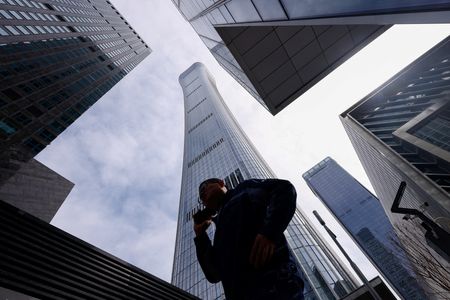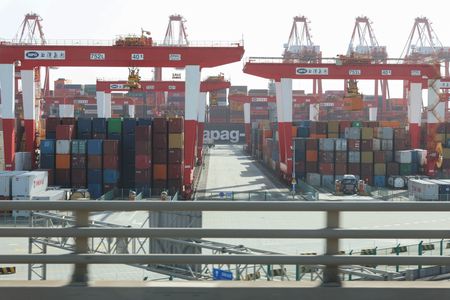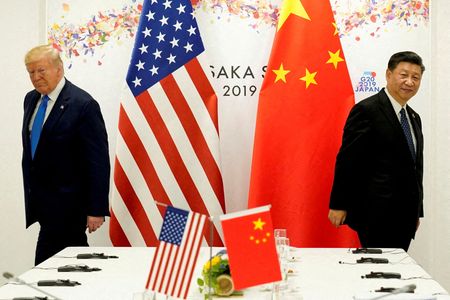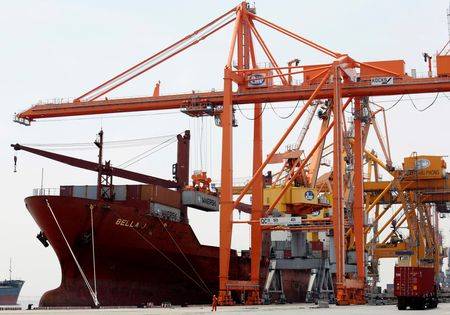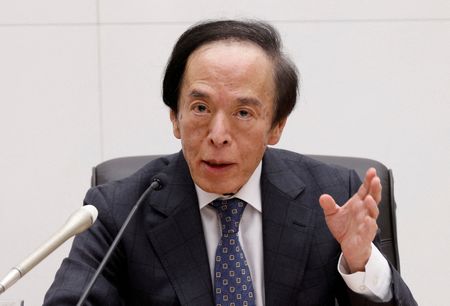By Kevin Yao
BEIJING (Reuters) -China’s economy likely slowed down in the first quarter while 2025 growth is expected to lag last year’s pace, a Reuters poll showed, ramping up pressure for more stimulus as surging U.S. tariffs threaten to deal a damaging blow to the Asian giant.
The world’s second-largest economy, which got off to a bumpy start this year, is facing one of its biggest challenges to its financial stability and growth as U.S. President Donald Trump ratchets up tariffs on its goods to eye-watering levels.
Gross domestic product growth in the first quarter is forecast at 5.1% year-on-year, slowing from 5.4% in October-December quarter, a Reuters poll of 57 economists showed on Friday.
Growth is likely to slow further to 4.5% in 2025, compared with last year’s 5.0% pace, according to the median forecast in the poll, falling short of the official target of around 5.0%.
Underscoring the testing times ahead for business and consumers, economic growth is expected to ease to 4.7% in the second quarter, the poll showed. The outlook darkens further in 2026 with analysts forecasting an even slower rate of growth of 4.2%.
“We see greater chance that domestic stimulus would be brought forward. We reckon that fiscal policies should lead domestic demand expansion amid external shocks,” Citi analysts said.
“The near-term focus could be on acceleration of policy implementation,” they added, tipping additional funding of 1.5 trillion yuan ($204.86 billion) around mid-year.
Trump announced a 90-day tariff pause on dozens of countries after his rapid-fire duties rocked financial markets, but ratcheted up tariffs on Chinese imports, raising them to an effective rate of 145%.
China has hit back against Trump’s tariffs, jacking up its duties on U.S. goods to 125% in a tit-for-tat row that has markets worried about a prolonged trade war between the world’s two biggest economies.
The trade spat with the United States comes as Chinese policymakers have struggled to revitalise the economy after the COVID-19 slump, as domestic demand remains sluggish due to weak confidence in the face of a years-long property market crisis and renewed deflationary pressure.
Recent data have pointed to an uneven recovery.
A nascent pick-up in retail sales and robust expansion in factory activity have been offset by rising unemployment.
China’s consumer prices fell for the second straight month in March while factory-gate deflation worsened, as the escalating U.S. trade war heightened worries about mounting piles of unsold exports that could drive domestic prices even lower.
China has set an ambitious 2025 growth target of “around 5%”, though analysts believe it may be increasingly difficult to achieve in the face of hefty U.S. tariffs.
Last week, global ratings agency Fitch downgraded China’s sovereign credit rating, citing rapidly rising government debt and risks to public finances, suggesting a tricky balancing act for policymakers seeking to expand consumption to guard against a trade downturn.
On a quarterly basis, the economy is forecast to have expanded 1.4% in the first quarter, slowing from 1.6% in October-December, the poll showed.
The government is due to release first quarter GDP data, along with March activity data, at 0200 GMT on April 16.
MORE STIMULUS IN PIPELINE
In March, China unveiled fiscal measures, including a rise in its annual budget deficit. Officials have flagged more fiscal and monetary stimulus to cope with rising headwinds.
The Politburo, a top decision-making body of the ruling Communist Party, is expected to hold a meeting later this month to set its policy agenda for the coming months.
The People’s Bank of China (PBOC) has repeatedly pledged to cut banks’ reserve requirement ratio (RRR) and interest rates at an appropriate time.
Analysts polled by Reuters expected the central bank to cut the RRR by at least 25 basis points (bps) in the second quarter, following a 50-basis point cut in September.
The PBOC is expected to cut the one-year loan prime rate (LPR), the benchmark lending rate, by 15 basis points in the second quarter.
Consumer inflation will likely pick up to 0.4% in 2025 from 0.2% in 2024 – well below the government’s target of around 2%, and rise further to 1.0% in 2026, the poll showed.
(For other stories from the Reuters global economic poll:)
($1 = 7.3222 Chinese yuan renminbi)
(Polling by Pranoy Krishna and Veronica Khongwir from Bengaluru and Jing Wang from Shanghai;Reporting by Kevin YaoEditing by Shri Navaratnam)

